Crucial DDR5 Pro OC 6400 CL32 Gaming DRAM Review
Crucial has always been the retail arm of memory maker Micron Technology, but it took the company a year from the time that it dropped its performance brand to realize that retail customers still wanted the retail component aesthetic. Another year passed before the firm could admit that performance memory was anything more than a viable niche: It needed a halo product to restore the shine it lost when giving up its halo brand. It took the firm yet another year to learn that DDR5-64000 C38 wouldn’t generate that kind of recognition, and today we’re finally back to where its Ballistix brand left off: One cycle of latency for every 100MHz of frequency. We welcome Crucial’s DDR5-6400 CAS 32 Pro OC Gaming kit.
| Crucial Pro OC Gaming [CP2K16G64C32U5(B/W)] | |
| Capacity | 32 GB (2x 16GB) |
| Data Rate | DDR5-6400 (XMP) |
| Primary Timings | 32-40-40-103 (2T) |
| Voltage | 1.35 Volts |
| Height | 34.9mm |
| Warranty | Lifetime |
| Price When Tested | $175 / $185 |
Quicker & Sleaker
Available in both black (CP2K16G64C32U5B) and white (CP2K16G64C32U5W), Crucial’s DDR5-6400 CL32 Pro OC Gaming 32GB kits come with two 16GB modules that timed at 32-40-40-103 latencies and girded with new screen-printed heat spreaders. At $175, the black version costs $10 less than the white.
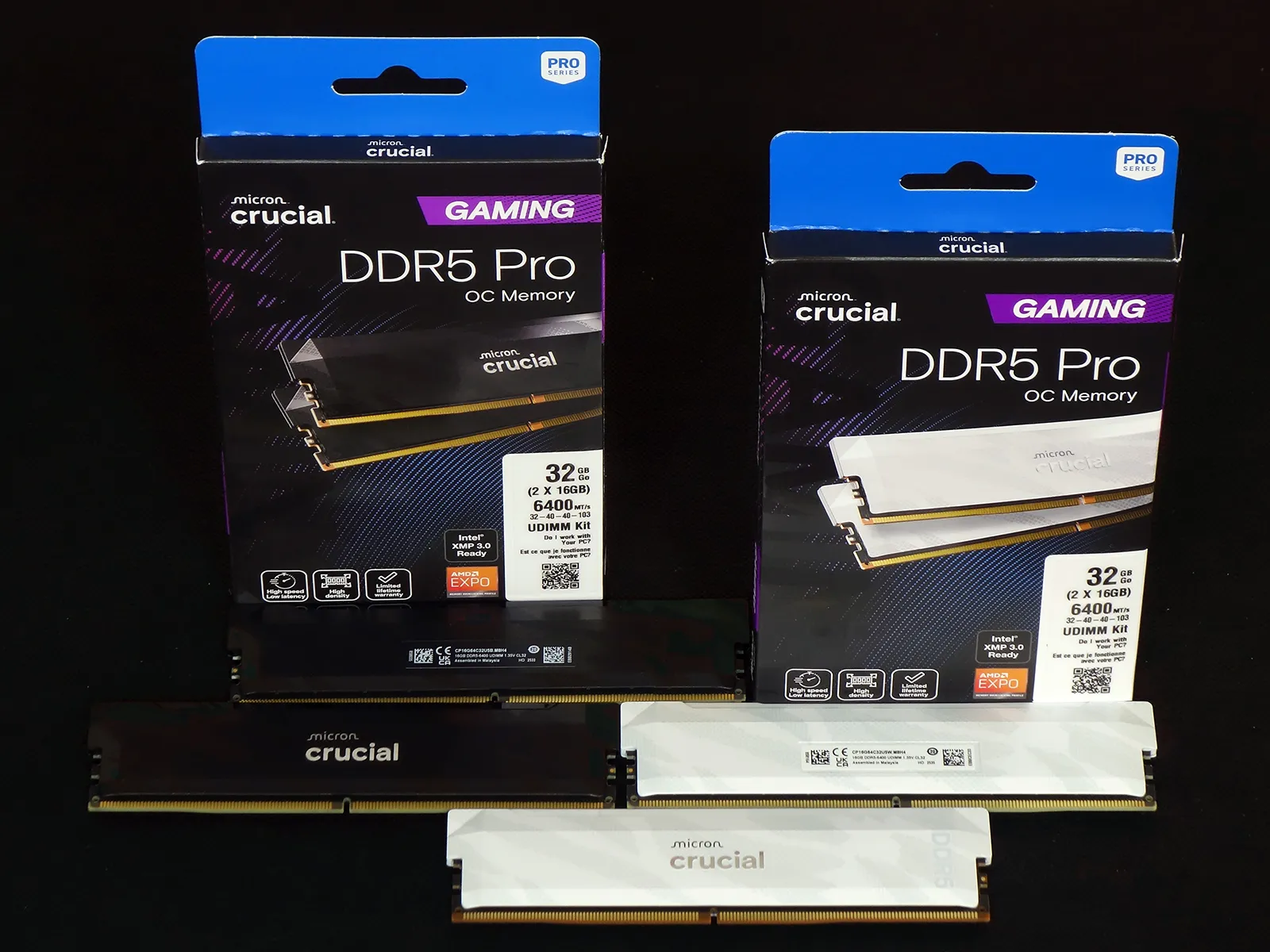
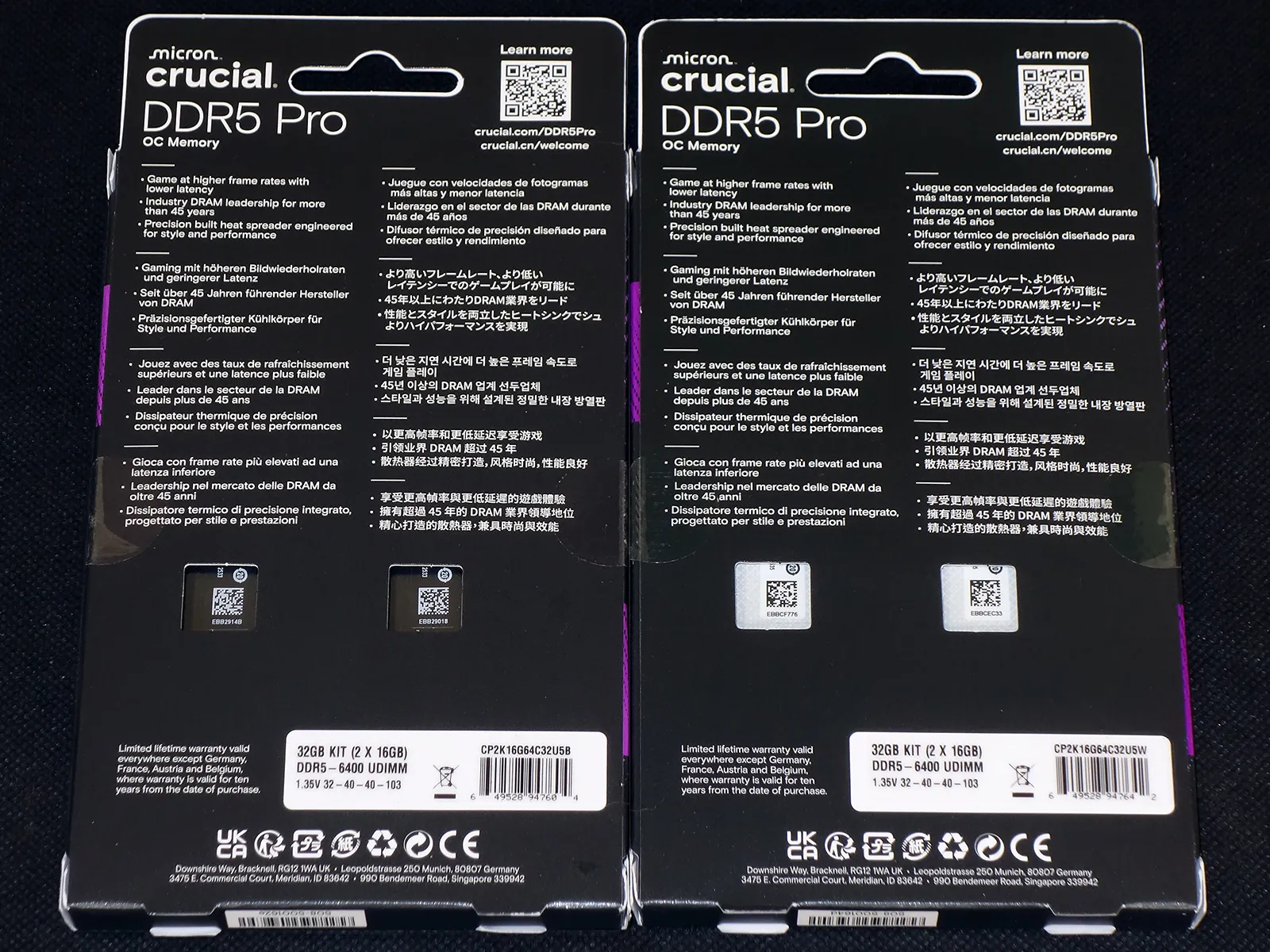
Since the ghost pattern applied to the sides of these modules uses texture rather than color to stand out, we altered the brightness and contrast on our subsequent photo to make it discernable across a wider variety of displays. Conversely, Crucial use color rather than texture—white lettering on black modules or black lettering on white—to place the Crucial Pro name atop the plastic ‘spine’ that fills the gap between those heat spreaders.
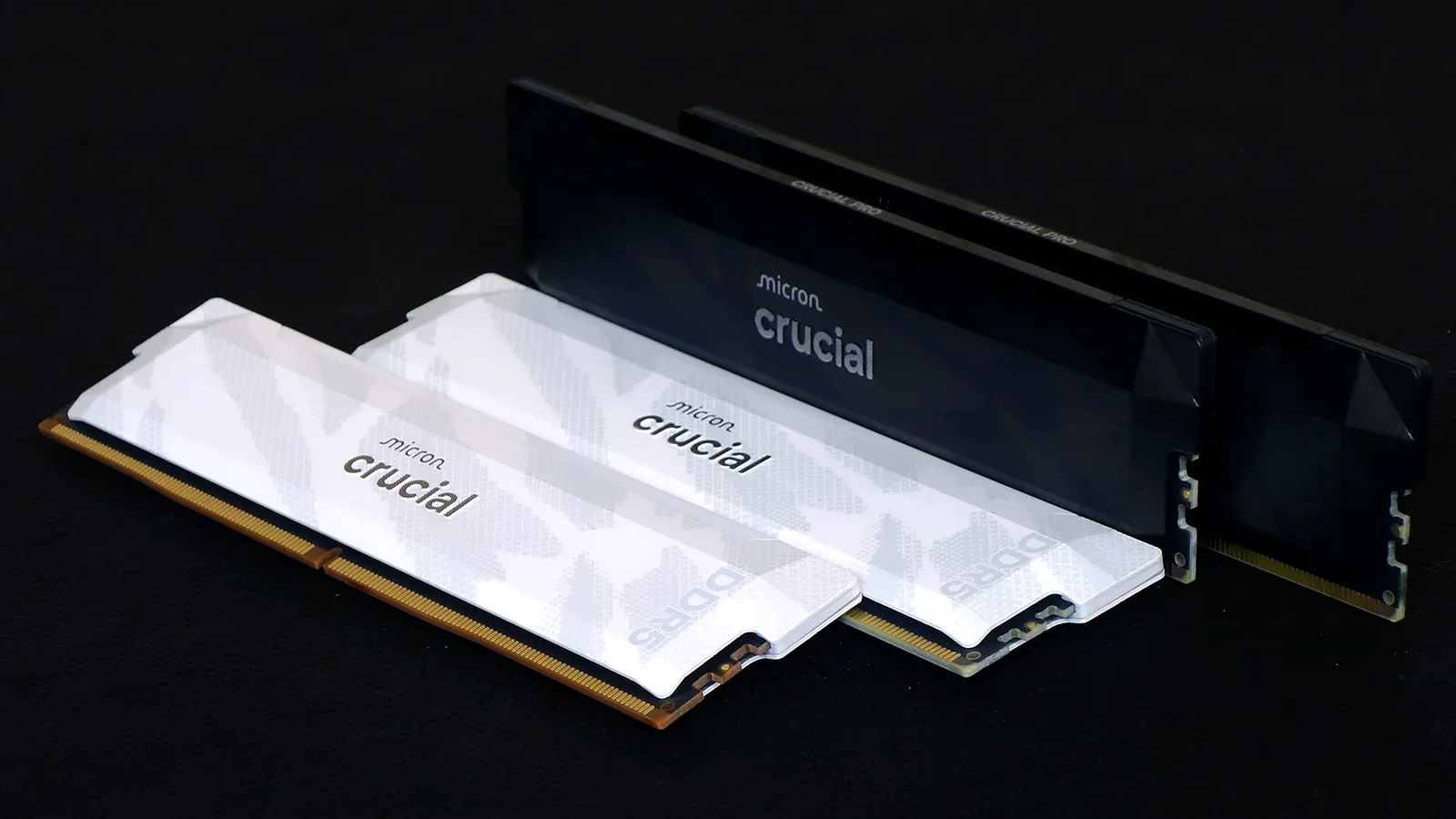
Programmed with both AMD EXPO and Intel XMP DDR5-6400 C32 values, today’s test kit is automatically configured at DDR5-5600 prior to enabling EXPO or XMP. Since Crucial understands that some processors aren’t stable at DDR5-6400, it also includes DDR5-6000 C36 EXPO and XMP values.
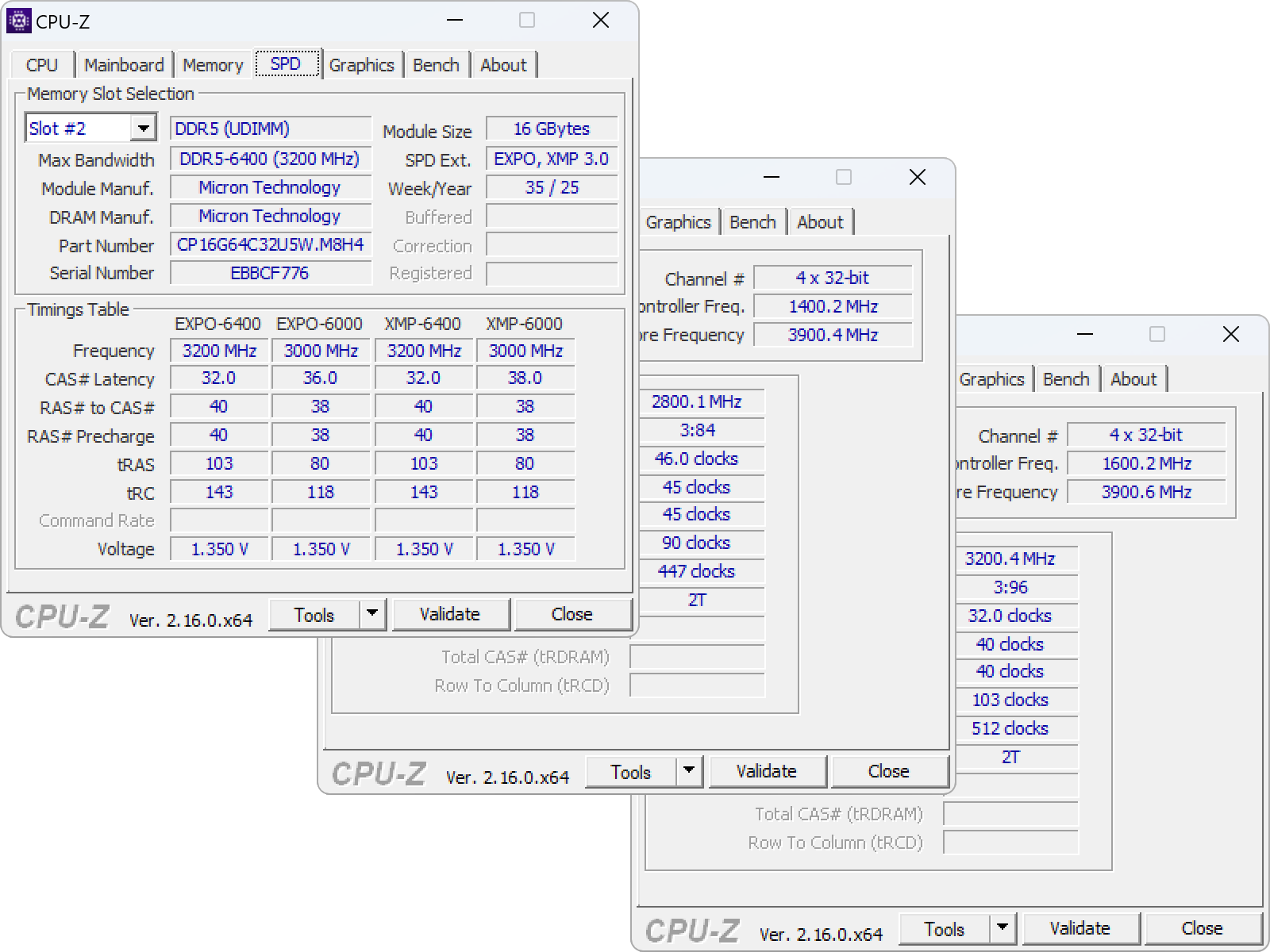
We noticed that the XMP tables are organized as two complete sets that include lesser alternatives, the first being DDR5-6400/6000/5600/5400/4800 and the second DDR5-6000/5333/5000/4667/4333/3667. Our motherboard only addresses the first two settings from the first configuration set, DDR5-6400 C32 and DDR5-6000 C36 (note that most frequencies are shown as clock rate rather than the doubled data rate).
| Memory SPD (as reported by CPU-Z v2.16.0 x64) | XMP profile | XMP-6000 | |
| Module Manufacturer(ID) | Micron Technology | Specification | 6000 CL38 |
| SDRAM Manufacturer (ID) | Micron Technology | VDD Voltage | 1.350 Volts |
| PMIC #0 | Enabled | VDDQ Voltage | 1.350 Volts |
| PMIC #0 Manufacturer | Richtek Power | VPP Voltage | 1.800 Volts |
| Max bandwidth | DDR5-6400 (3200 MHz) | Memory Controller Volt. | 1.300 Volts |
| Max JEDEC | DDR5-5600 (2800 MHz) | Min Cycle time | 0.333 ns (3000 MHz) |
| Part number | CP16G64C32U5W.M8H4 | Max CL | 37 |
| Manufacturing date | Week 35/Year 25 | Min tRP | 12.65 ns |
| Nominal Voltage | 1.10 Volts | Min tRCD | 12.65 ns |
| Temperature Limit | 55.0 degC (high limit), 85.0 degC (critical limit) | Min tRAS | 26.64 ns |
| XMP | yes, rev. 3.0 | Min tRC | 39.29 ns |
| EXPO | yes, rev. 1.0 | XMP timings table | CL-tRCD-tRP-tRAS-tRC-CR @ frequency (voltage) |
| JEDEC timings table | CL-tRCD-tRP-tRAS-tRC @ frequency | XMP #1 | 22.0-24-24-49-73-n.a @ 1833 MHz (1.350 Volts) |
| JEDEC #1 | 22.0-22-22-44-66 @ 1366 MHz | XMP #2 | 26.0-28-28-58-86-n.a @ 2166 MHz (1.350 Volts) |
| JEDEC #2 | 26.0-27-27-53-79 @ 1633 MHz | XMP #3 | 28.0-30-30-63-92-n.a @ 2333 MHz (1.350 Volts) |
| JEDEC #3 | 28.0-29-29-57-85 @ 1766 MHz | XMP #4 | 30.0-32-32-67-99-n.a @ 2500 MHz (1.350 Volts) |
| JEDEC #4 | 30.0-30-30-60-90 @ 1866 MHz | XMP #5 | 32.0-34-34-72-105-n.a @ 2666 MHz (1.350 Volts) |
| JEDEC #5 | 32.0-32-32-64-96 @ 2000 MHz | XMP #6 | 36.0-38-38-80-118-n.a @ 3000 MHz (1.350 Volts) |
| JEDEC #6 | 36.0-37-37-73-109 @ 2266 MHz | XMP #7 | 38.0-38-38-80-118-n.a @ 3000 MHz (1.350 Volts) |
| JEDEC #7 | 40.0-40-40-80-120 @ 2500 MHz | XMP #8 | 40.0-38-38-80-118-n.a @ 3000 MHz (1.350 Volts) |
| JEDEC #8 | 42.0-43-43-85-127 @ 2633 MHz | XMP #9 | 42.0-38-38-80-118-n.a @ 3000 MHz (1.350 Volts) |
| JEDEC #9 | 46.0-45-45-90-135 @ 2800 MHz | EXPO profile | |
| JEDEC #10 | 50.0-45-45-90-135 @ 2800 MHz | VDD Voltage | 1.350 Volts |
| XMP profile | XMP-6400 | VDDQ Voltage | 1.350 Volts |
| Specification | 6400 CL32 | VPP Voltage | 1.800 Volts |
| VDD Voltage | 1.350 Volts | Min Cycle time | 0.312 ns (3200 MHz) |
| VDDQ Voltage | 1.350 Volts | Max CL | 32 |
| VPP Voltage | 1.800 Volts | Min tRP | 12.48 ns |
| Memory Controller Volt. | 1.350 Volts | Min tRCD | 12.48 ns |
| Min Cycle time | 0.312 ns (3200 MHz) | Min tRAS | 32.00 ns |
| Max CL | 32 | Min tRFC | 0.29 ns |
| Min tRP | 12.48 ns | EXPO timings table | CL-tRCD-tRP-tRAS-tRC @ frequency |
| Min tRCD | 12.48 ns | EXPO #1 | 32.0-40-40-103-143 @ 3200 MHz |
| Min tRAS | 32.00 ns | EXPO profile | |
| Min tRC | 44.48 ns | VDD Voltage | 1.350 Volts |
| XMP timings table | CL-tRCD-tRP-tRAS-tRC-CR @ frequency (voltage) | VDDQ Voltage | 1.350 Volts |
| XMP #1 | 22.0-28-28-71-99-n.a @ 2203 MHz (1.350 Volts) | VPP Voltage | 1.800 Volts |
| XMP #2 | 26.0-33-33-84-116-n.a @ 2604 MHz (1.350 Volts) | Min Cycle time | 0.333 ns (3000 MHz) |
| XMP #3 | 28.0-35-35-90-125-n.a @ 2804 MHz (1.350 Volts) | Max CL | 36 |
| XMP #4 | 30.0-38-38-97-134-n.a @ 3004 MHz (1.350 Volts) | Min tRP | 12.65 ns |
| XMP #5 | 32.0-40-40-103-143-n.a @ 3200 MHz (1.350 Volts) | Min tRCD | 12.65 ns |
| XMP #6 | 36.0-40-40-103-143-n.a @ 3200 MHz (1.350 Volts) | Min tRAS | 26.64 ns |
| XMP #7 | 38.0-40-40-103-143-n.a @ 3200 MHz (1.350 Volts) | Min tRFC | 0.29 ns |
| XMP #8 | 40.0-40-40-103-143-n.a @ 3200 MHz (1.350 Volts) | EXPO timings table | CL-tRCD-tRP-tRAS-tRC @ frequency |
| XMP #9 | 42.0-40-40-103-143-n.a @ 3200 MHz (1.350 Volts) | EXPO #1 | 36.0-38-38-80-118 @ 3000 MHz |
Our Test
Intel’s Core Ultra 9 285K will provide the load for evaluating today’s Pro OC Gaming kit, while ASRock’s Z890 Taichi Lite provides the stable input voltage and timing adjustments to get us to our goals.
| Test Hardware | |
| CPU | Intel Core Ultra 9 285K: 24 Cores, 36M Cache, 3.2- 5.70 GHz, LGA 1851 |
| CPU Cooler | Alphacool Core 1 Aurora CPU, VPP655 with Eisbecher D5 150mm, NexXxoS UT60 X-Flow |
| Motherboard | ASRock Z890 Taichi Lite, BIOS 3.04 |
| Graphics | ASRock RX 7700 XT Phantom Gaming 12GB OC |
| Hard Drive | Crucial T700 PCIe Gen5 2TB M.2 SSD |
Pro OC Gaming DDR5-6400 CL32 Overclocking & Latency Tuning
We only reduce primary timings to perform our overclocks, so we’re not surprised to see a kit with tighter overall timings take third place in manual overclocking. It’s more important for us to see how it performs at those overclocks.
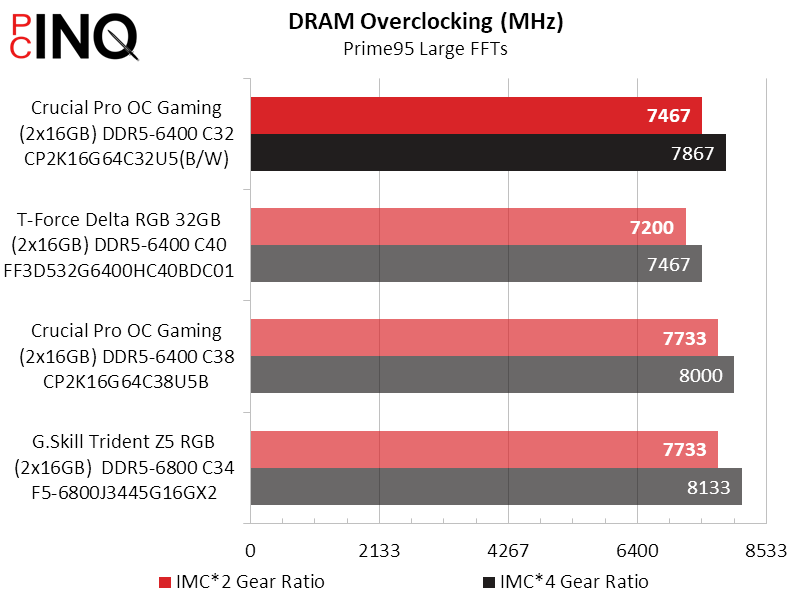
We could not tighten any further the 6400 C32’s three most significant timings, but we did manage to drop TRAS from the 103-cycle default to 84 cycles. Remember that the fewer cycles of latency a module has, the more quickly it can begin the next transfer.
| Lowest Stable Timings | |||
| DDR5-6400 | DDR5-5600 | DDR5-4800 | |
| Crucial Pro OC Gaming (2x16GB) DDR5-6400 C32 | 32-40-40-84 (2T) | 36-36-36-72 (2T) | 35-30-30-60 (2T) |
| T-Force Delta RGB 32GB (2x16GB) DDR5-6400 C40 | 34-38-38-76 (2T) | 28-33-33-66 (2T) | 26-30-30-60 (2T) |
| Crucial Pro OC Gaming (2x16GB) DDR5-6400 C38 | 34-37-37-74 (2T) | 34-32-32-64 (2T) | 32-28-28-56 (2T) |
| G.Skill Trident Z5 RGB (2x16GB) DDR5-6800 C34 | 32-38-38-76 (2T) | 28-33-33-66 (2T) | 24-28-28-56 (2T) |
Because a lower memory controller divisor (aka Intel “Gear Ratio”) results in lower benchmark latency, we first benchmarked the new Pro OC kit at DDR5-7467 Gear 2. When it came up far short on bandwidth of the older C38 Pro OC Gaming, we decided to go ahead and retest at its higher DDR5-7867 Gear 4. Those results will be shown in our benchmark charts, right between its XMP default and latency optimized configurations.
Pro OC Gaming DDR5-6400 CL32 Benchmark Results
The higher overclock allowed by Intel’s Gear 4 memory ration (ie, ¼ DRAM clock) gave the new kit almost enough overclocked bandwidth to reach its predecessors, but also hurt it badly in both Sandra and AIDA64 Latency.
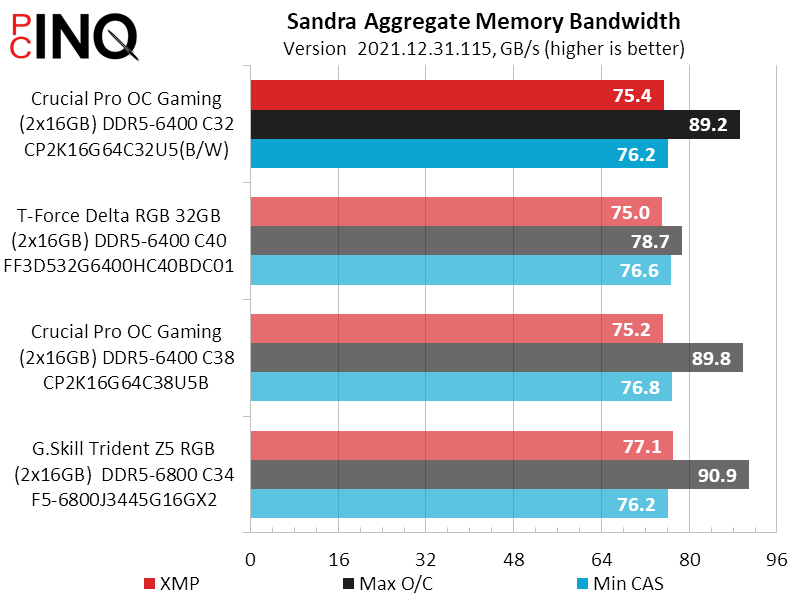
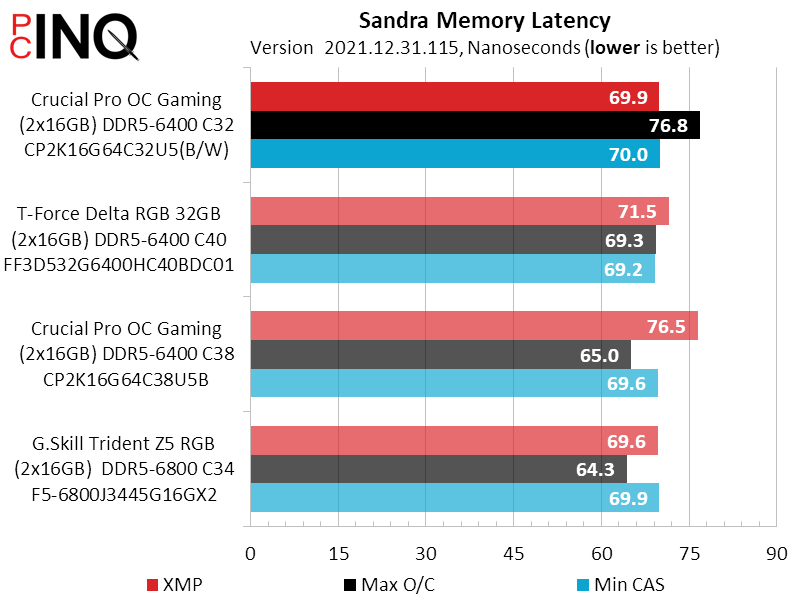
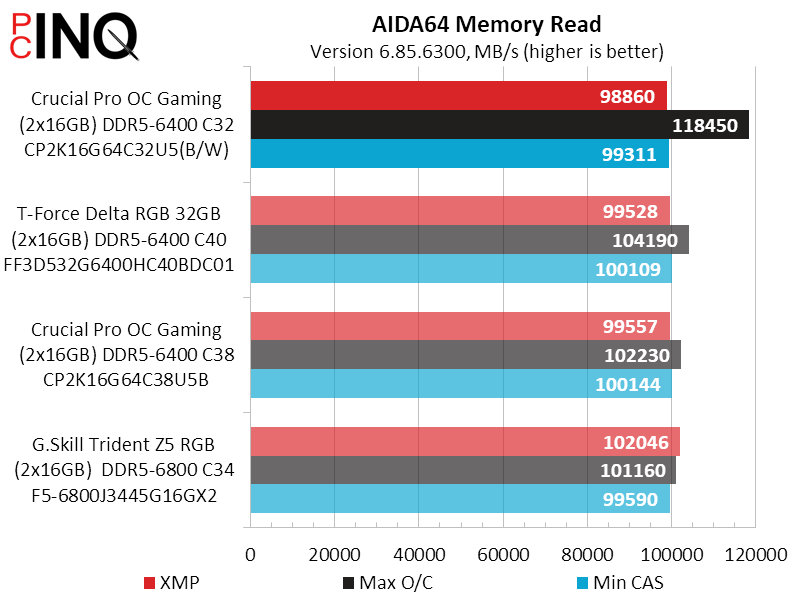
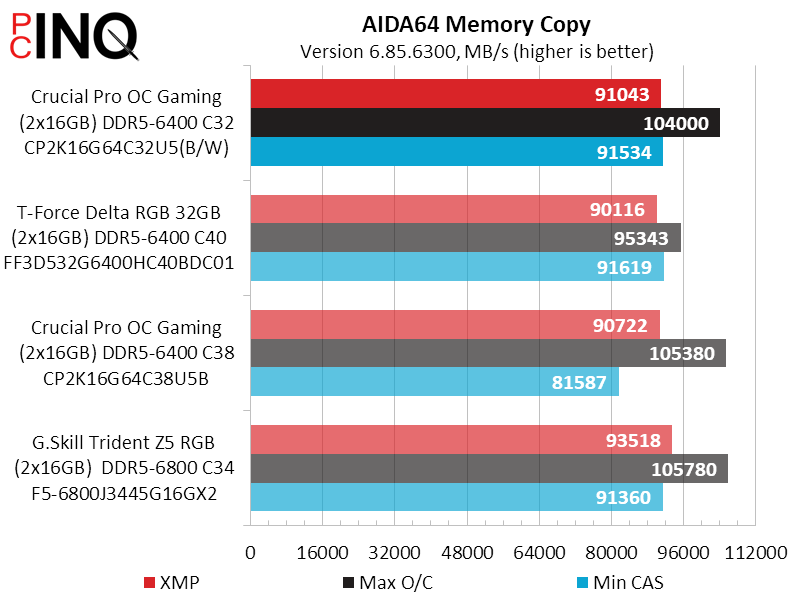
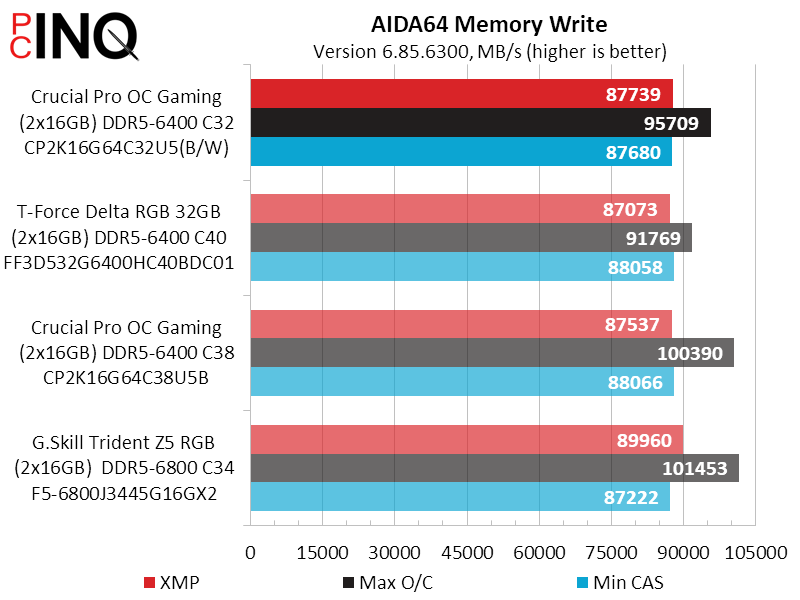
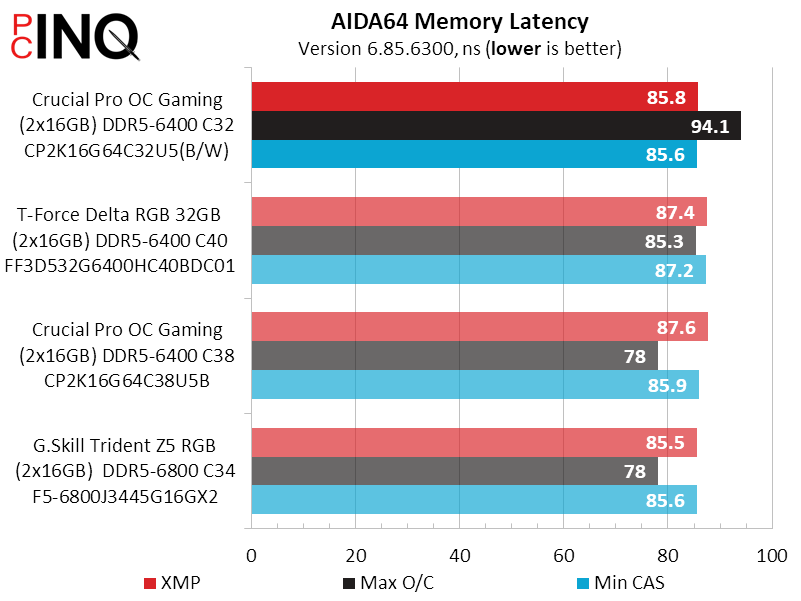
There’s really nothing to see in 3DMark, as the kits we tested were all too close in latency and bandwidth to produce a noticeable impact on benchmarks that are only modestly dependent on those two things.
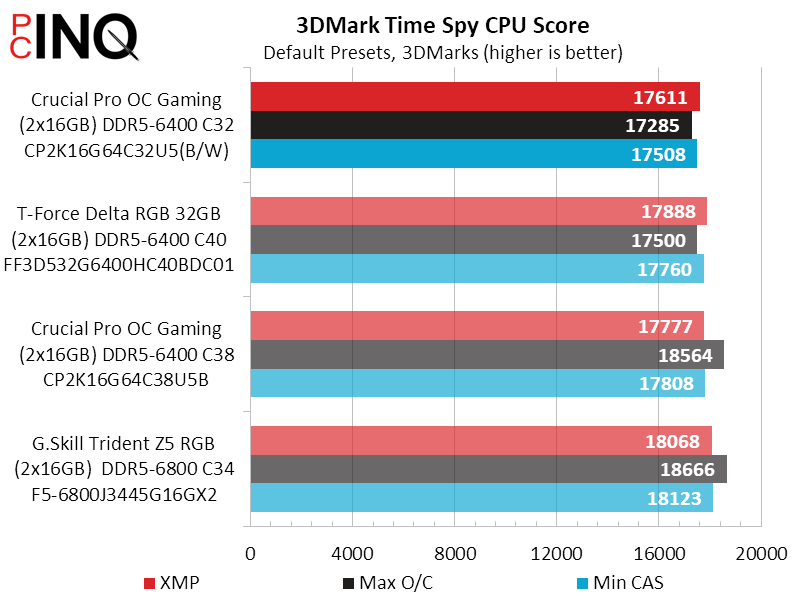
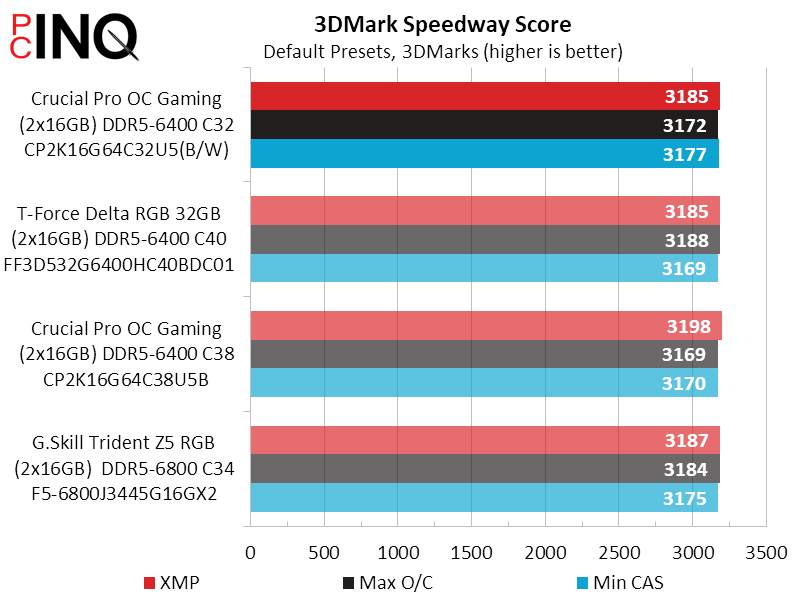
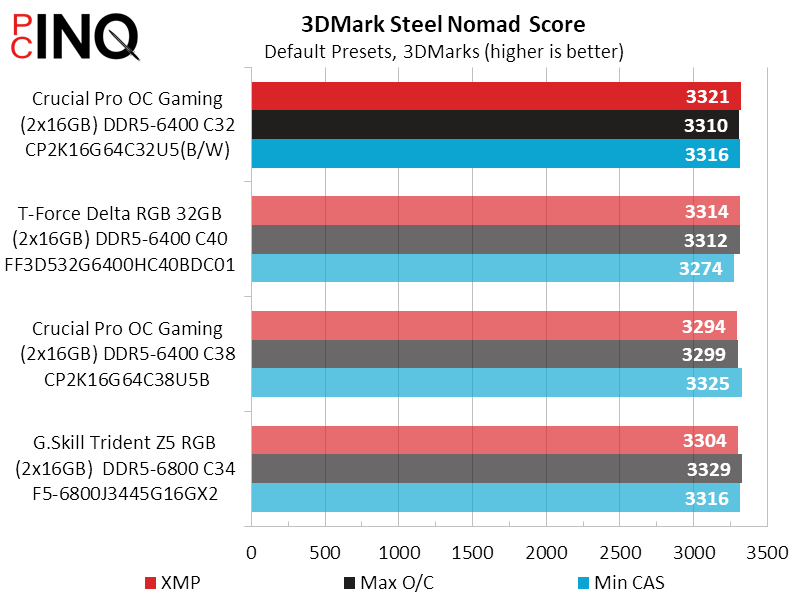
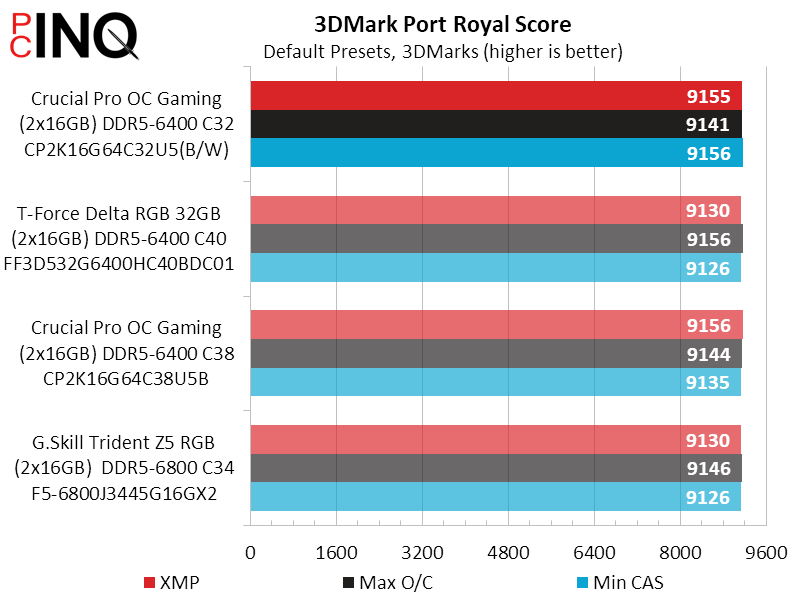
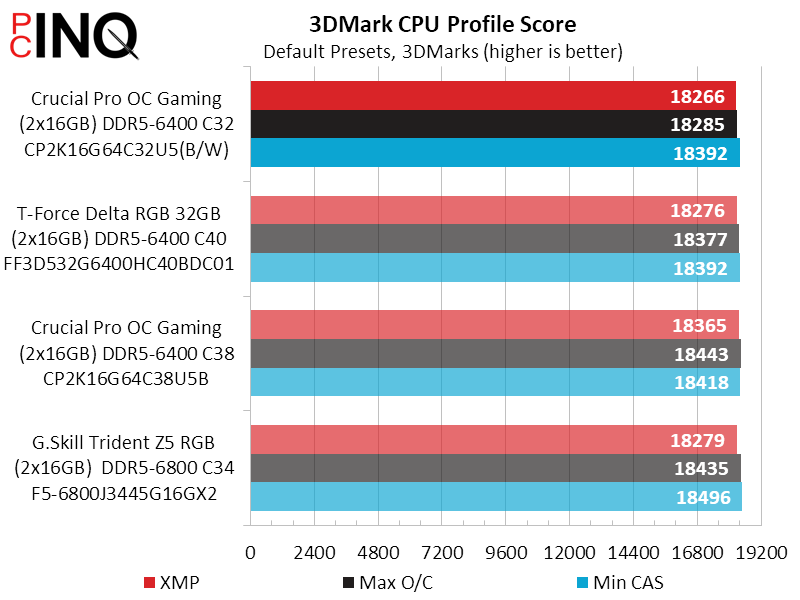
We’ve always known the EGO gaming engine to be at least somewhat impacted by memory performance, but much of that went away when we moved past DDR4’s limitations. For its part, Crucial recommends testing with DiRT 5 rather than F1 2021, so we might have picked our EGO game badly. Regardless, Crucial also lists Cyberpunk 2077 and SOTR as affected games, and we don’t see that playing out in our charts either. Perhaps we’re graphics limited?
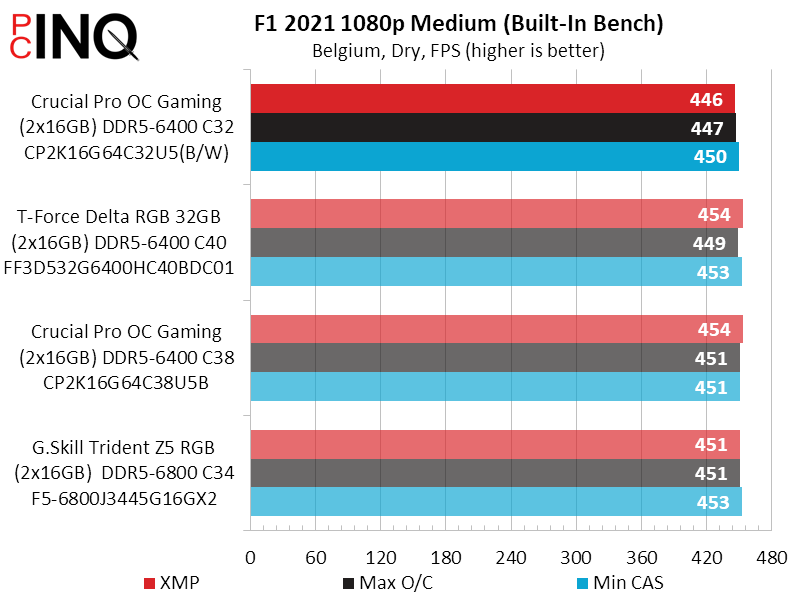
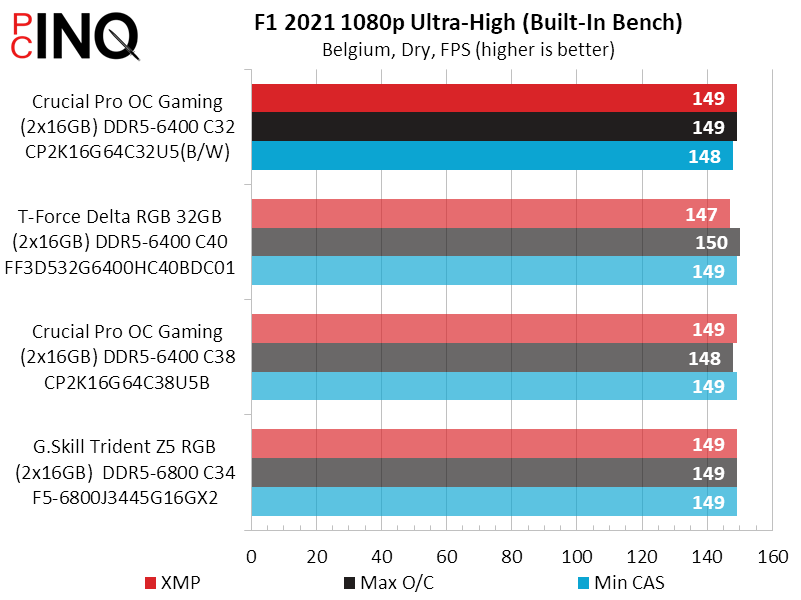
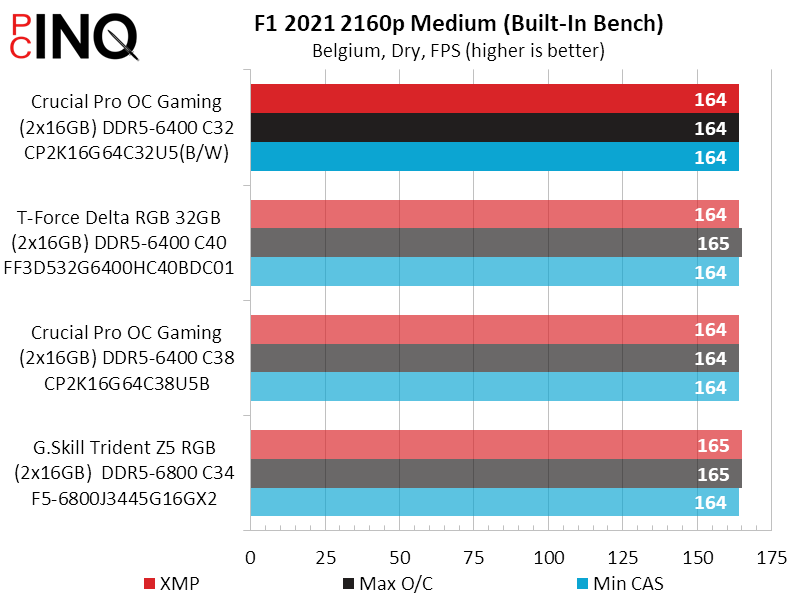
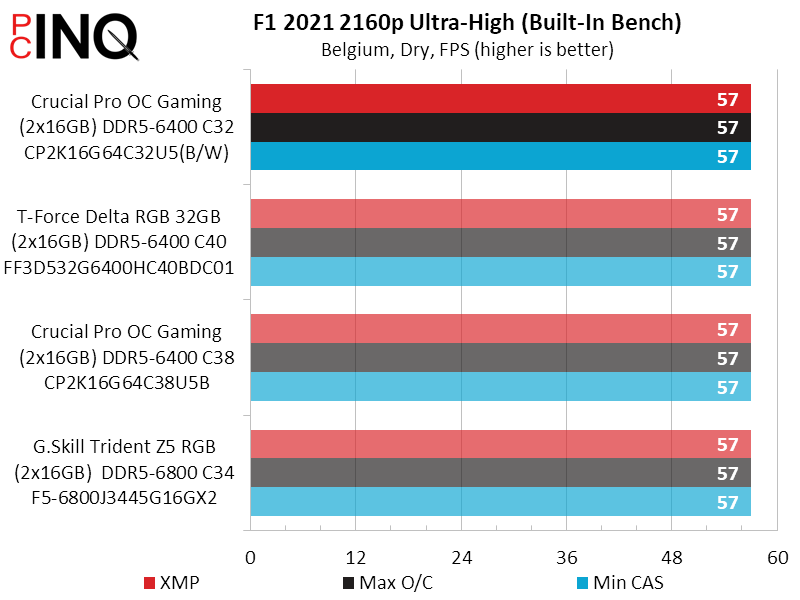
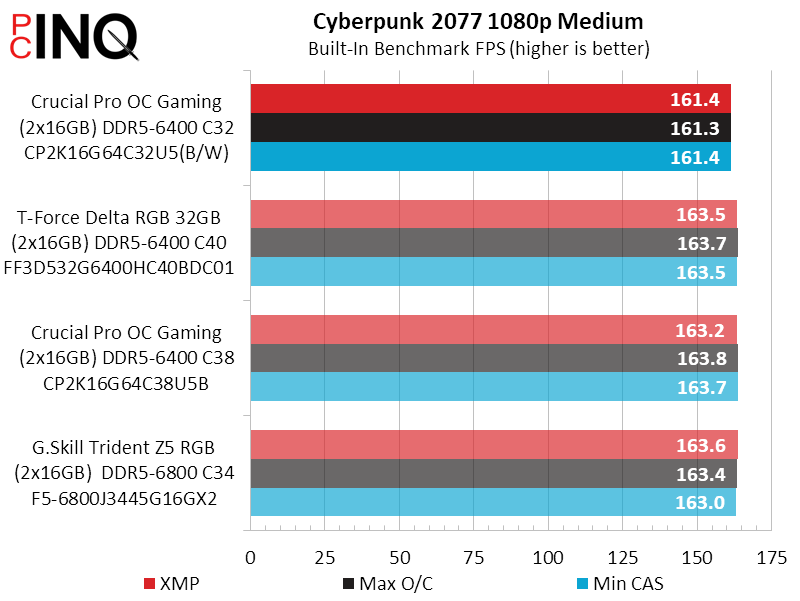
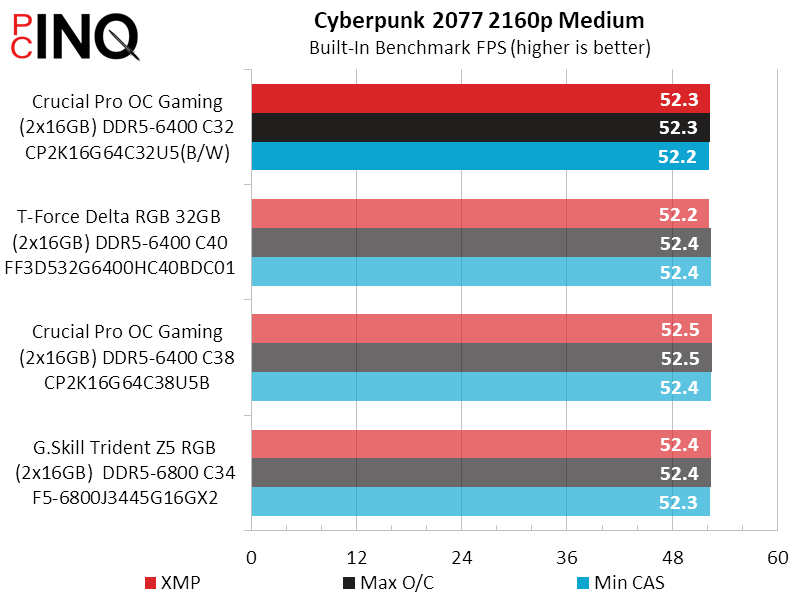
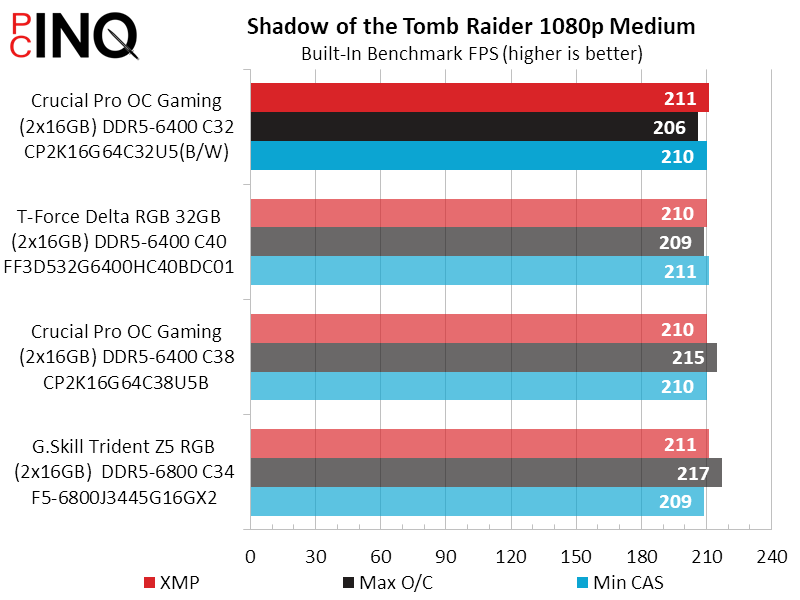
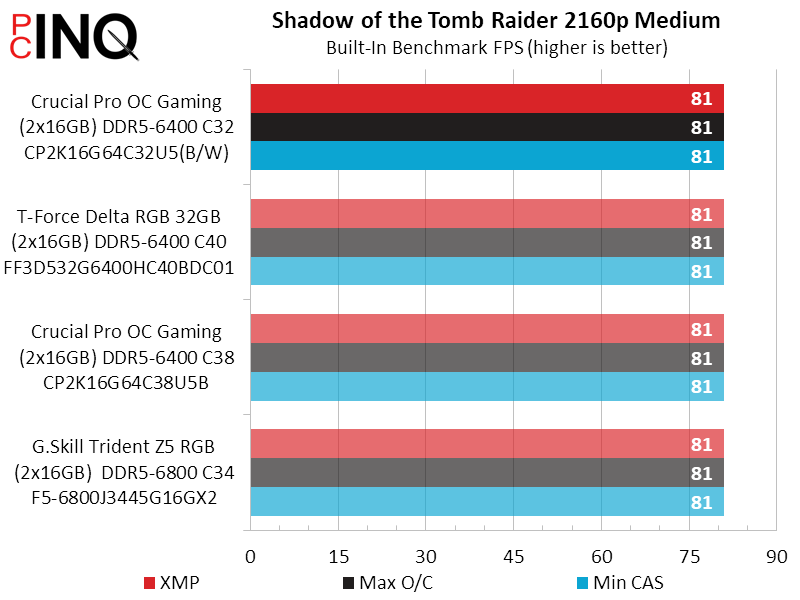
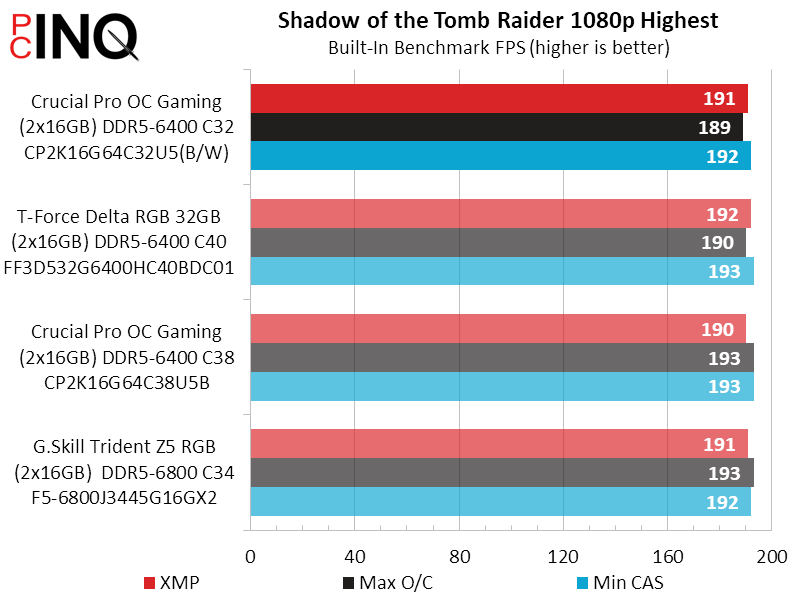
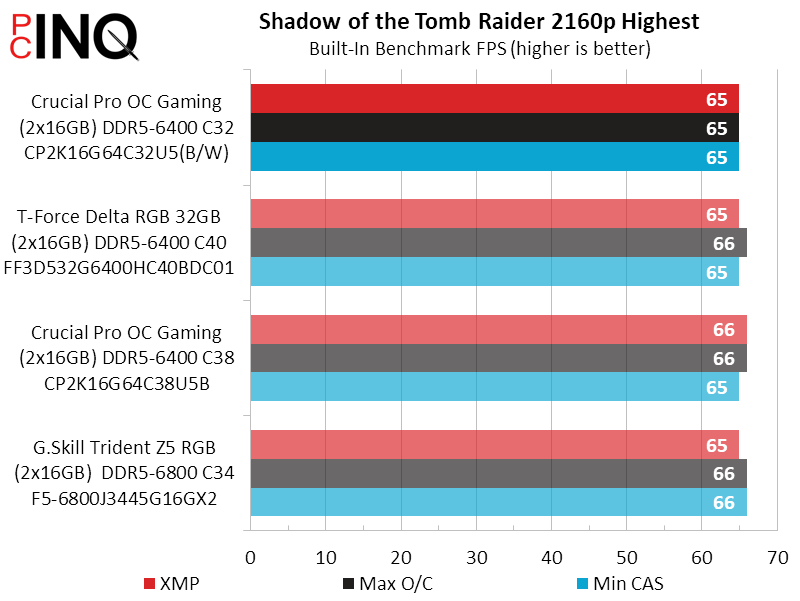
Crucial Pro OC Gaming DDR5-6400 CL32’s XMP takes second place behind the wildly expensive Trident Z5 DDR5-6800 C34 in 7.Zip and Corona Benchmark.
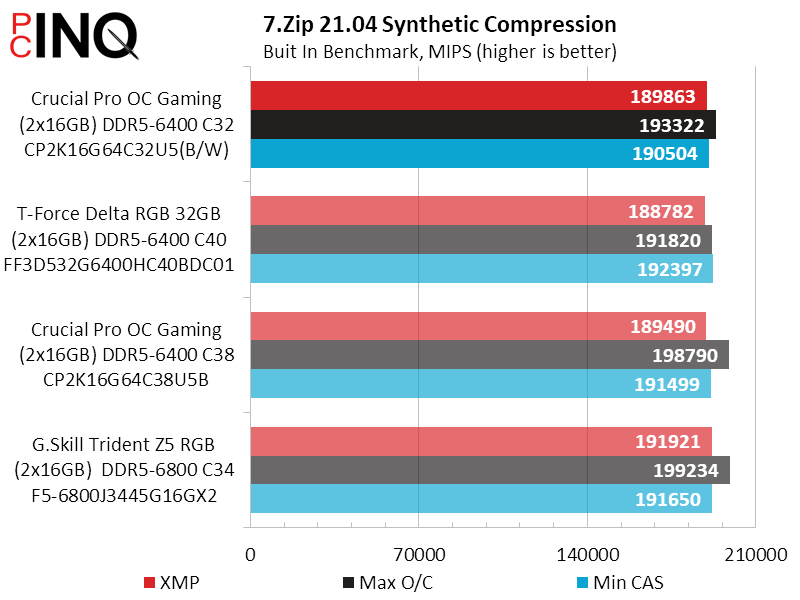
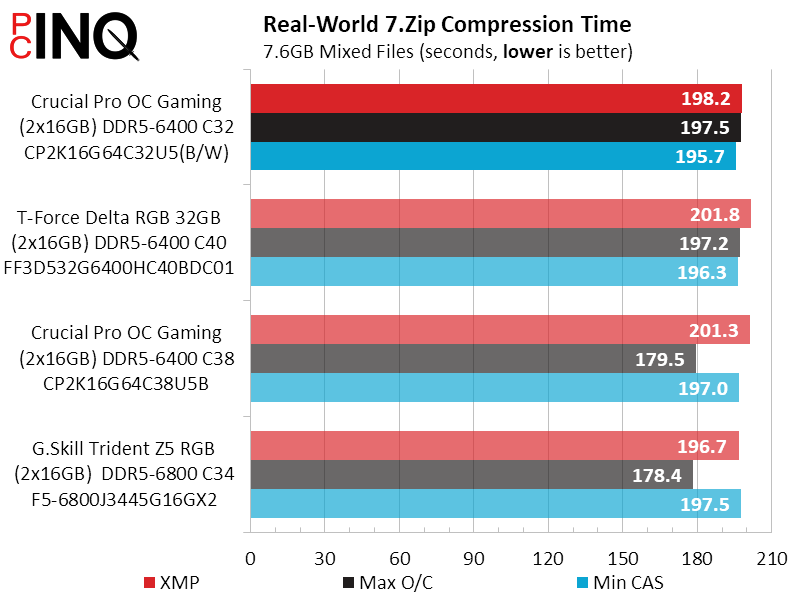
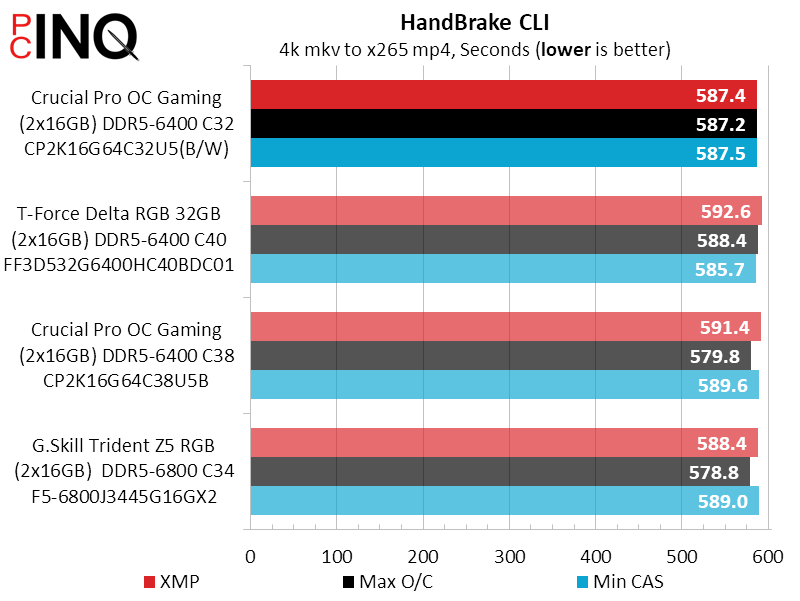
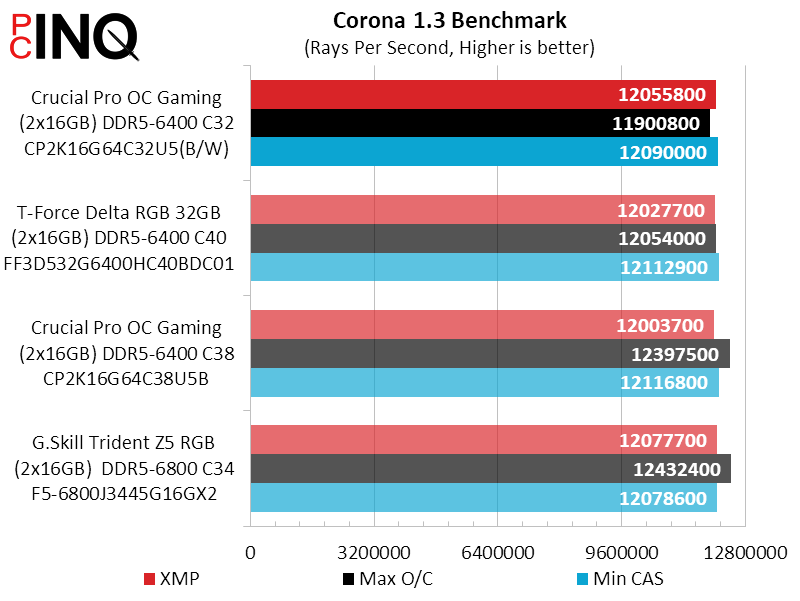
And, by the end of our test the new kit’s XMP appears to take a first-place tie. We checked the data and it actually feel 0.3% behind the G.Skill kit, 102.8% to 103.1%.
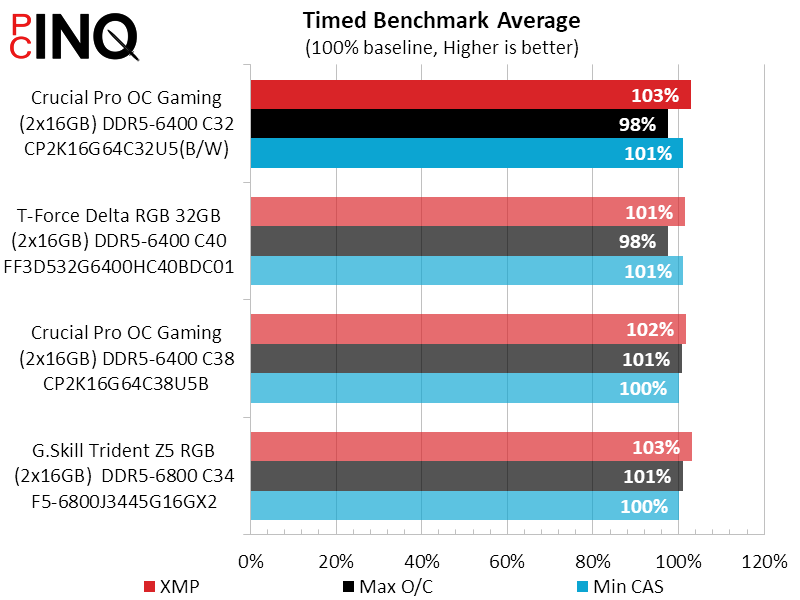
We also did some performance to price analysis and came to the conclusion that Crucial’s old DDR5-6400 C38 is still the value leader by a fairly large margin, though the older kit’s price might simply be lagging behind the market’s current price surge.
| Crucial Pro OC Gaming model CP2K16G64C32U5W | |
| Pros | Cons |
| Great XMP & EXPO Timings Attractive new look | White costs $10 more than black Very little room left for tweaks |
| The Verdict | |
| The Pro OC Gaming DDR4-6400 CL32 kit’s tight XMP & EXPO timing are a perfect match to a performance market that doesn’t usually to tune its memory manually. | |
For now, the new DDR5-6400 CL32 version of Crucial’s Pro OC Gaming sits between its priciest rival in performance and its thriftier predecessor in price. If you’re value-minded performance seeker, that seems like a fairly good place to be.
Find it at Amazon

(click for availability)

